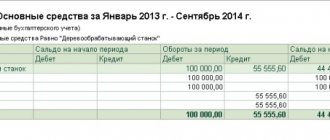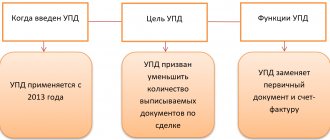Off-balance sheet account 002 - what is it intended for?
Off-balance sheet accounts in accounting are intended to reflect values that do not belong to the enterprise by right of ownership, that is, those that are in temporary use. These can be not only inventory items, but also conditional rights and obligations:
Account 002 in accounting is an active account; any receipt of inventory items is reflected as a debit of the account, and disposal (movement) as a credit. Valuables in accounting account 002 are accepted at the value indicated in the accompanying documents. If there is no value, then in a conditional or quantitative assessment.
Typical entry
In the updated editions of the accounting instructions, a standard entry is proposed for the write-off of fixed assets: Debit of the corresponding analytical accounts of account 0 104 00 000 “Depreciation” Debit of account 0 11400 000 “Impairment of non-financial assets” Debit of account 0 40110 172 “Income from transactions with assets » Credit of analytical accounting accounts account 0 10100 000 “Fixed assets”. At the same time, if a discrepancy is identified with the conditions for recognition of an asset (in particular, objects that have fallen into disrepair), a decision is made to terminate the operation of an accounting object, including due to physical or moral wear and tear, or a decision is made to write off objects simultaneously with the above entry, it is necessary to reflect the disposal from the operation of property on off-balance sheet account 02 until its dismantling and (or) disposal or until the objective function of the property removed from the balance sheet is determined. Unfortunately, neither the GHS OS nor the accounting instructions clearly indicate in what order and on the basis of which accounting documents impairment should be reflected. It is obvious that until the relevant clarification is issued, the Ministry of Finance will have to make such decisions within the framework of the institution’s accounting policy.
Which inventory items are taken into account on account 002
Let's take a closer look at account 002 “Inventory assets accepted for safekeeping.” Account 002 takes into account values that the company, for a number of reasons, cannot reflect on the balance sheet:
- The received goods are defective, damaged, do not meet the stated requirements and characteristics specified in the supply agreement and must be returned to the supplier;
- According to the terms of the contract, ownership of the goods passes not at the time of shipment, but upon payment;
- Inventory and materials are accounted for under the pledge agreement;
- Inventory and materials have been paid for by the buyer, but have not yet been transported from the warehouse for technical or other valid reasons, that is, they are temporarily in safekeeping;
- Inventory and materials were received from the bailor under a storage agreement;
- The goods and materials were received by mistake, by an exchange agreement, etc.
Registration of write-off of fixed assets in "1C: Accounting of a government institution 8"
In the program "1C: Accounting of a State Institution 8" edition 1, the following documents are used to write off fixed assets that no longer meet the criteria for recognition of an asset: Write-off of an inventory item, Write-off of household items. inventory, Write-off of the library collection with the operation Disposal of fixed assets that have become unusable and for the needs of the institution (401.10.172).
To reflect objects on off-balance sheet account 02 “Tangible assets accepted for storage”, the Accept for storage flag (02.1) should be set in the document. More information about writing off fixed assets to off-balance sheet account 02 can be read in the methodological support section of edition 1 of the program on the ITS-BUDGET resources, in the article “Disposal of fixed assets that have fallen into disrepair.”
In edition 2 of the program “1C: Public Institution Accounting 8” the following documents are used:
- Write-off of fixed assets, intangible assets, legal documents (except for transport) with the standard operation Write-off of deteriorated fixed assets, intangible assets, legal documents (401.10.172);
- Write-off of vehicles with the standard operation Write-off of vehicles that have become unusable (401.10.172);
- Write-off of soft and household goods. inventory (OS) with the standard operation Write-off of household items. Inventory;
- Write-off of library funds with a standard operation Write-off of library funds that have become unusable.
To reflect objects on off-balance sheet account 02 “Tangible assets accepted for storage”, the Accept for storage flag (02.1) should be set in the document (Fig. 1).
Rice. 1.
When posting a document in “1C: Public Institution Accounting 8”, accounting records are generated for writing off the book value and depreciation in correspondence with account 401.10.172 “Income from transactions with assets”, as well as for accepting for accounting into the off-balance sheet account 02.1 “Fixed assets accepted for safekeeping" in a conditional valuation: one object - one ruble.
According to paragraph 335 of Instruction No. 157n, material assets received (accepted) by an institution are accounted for in off-balance sheet account 02 “Tangible assets accepted for storage” on the basis of a primary document confirming receipt (acceptance for storage (for processing)) by the institution of material assets, according to the value indicated in the document by the transferring party (at the cost stipulated by the contract), and in the case of unilateral execution of the act by the institution in the conditional valuation: one object, one ruble.
In this case, the act is drawn up by the institution unilaterally, therefore, objects are accepted for accounting in off-balance sheet account 02.1 “Assets accepted for safekeeping” at a conditional valuation: one object - one ruble.
From the documents, both an Act on the write-off of non-financial assets (except vehicles) (form 0504104) and an Accounting Certificate (form 0504833) can be generated.
Reply from 07/21/2015:
According to clause 373 of Instruction No. 157n (approved by order of the Ministry of Finance of Russia dated December 1, 2010 No. 157n), the disposal of fixed assets from off-balance sheet accounting, including in connection with the decision to write them off (destruction), is carried out on the basis of the Write-off Certificate at the cost at which the objects were previously accepted for off-balance sheet accounting.
Thus, Instruction No. 157n does not establish any special requirements for write-offs from off-balance sheet account 21, except for the preparation of a Write-off Certificate. There is also no special form for the Write-off Act for this case. None of the forms of primary documents described in Appendix No. 5 to Order No. 173n of the Ministry of Finance of Russia dated December 15, 2010 (valid until June 18, 2015) are indicated as intended for documenting the write-off of fixed assets worth up to 3,000 rubles inclusive.
Consequently, during the period of Order No. 173n, the institution was obliged to independently approve in its accounting policy the form of the primary document for documenting the write-off of fixed assets from off-balance sheet account 21. According to clause 51 of Instruction No. 157n, the disposal of inventory items of fixed assets, including movable objects property worth up to 3,000 rubles inclusive, accounted for off-balance sheet, is reflected on the basis of the decision of the commission on receipt and disposal of assets, formalized in the prescribed manner by the corresponding primary accounting document (Act). This means that the form of the Act should have provided for the conclusion of the commission and the signatures of the commission members.
On June 19, 2015, Order No. 52n of the Russian Ministry of Finance dated March 30, 2015 (hereinafter referred to as Order No. 52n) came into effect. As indicated in the letter of the Ministry of Finance of Russia dated June 10, 2015 No. 02-07-07/33768, the application by an institution of new forms of primary documents established by Order No. 52n begins from the date established by the accounting policy of the institution. Order No. 52n introduced a unified form, Act on the write-off of non-financial assets (except for vehicles) (f.0504104), which is intended for documenting the write-off of all types of non-financial assets, except for raw materials, supplies, as well as finished products produced by the institution. This means, starting from the date established by the accounting policy of the institution (but not earlier than 06/19/2015), the write-off of fixed assets listed in account 21 should be documented by the Act on the write-off of non-financial assets (f.0504104). This form also contains columns for indicating the reason for the write-off and the signatures of the commission members.
When deciding to write off fixed assets listed on off-balance sheet account 21, the institution’s commission must justify:
- that the fixed asset is no longer suitable for use; Obviously, the commission’s conclusion should describe in detail what exactly is its malfunction/unsuitability; if the commission simply writes “does not work” in relation to the phone, this does not yet confirm the need to write off the phone (perhaps the electrical contact has been broken);
- that the fixed asset is impossible or too expensive to repair; If the phone's contact is broken, it may be cheaper to repair it than to write it off.
If the members of the commission are sufficiently qualified to determine what the malfunction of the phone is, what is the possibility of repairing it, how much such a repair may cost, then the conclusion of the commission (where the malfunction will be described in detail and the inappropriateness of the repair will be justified) can be considered reasonable. If the members of the commission do not have documented qualifications to determine faults and repair possibilities for office and household appliances, it is obvious that the decisions of such a commission are not sufficiently substantiated. In this case, the commission may involve outside experts.
Typical transactions for off-balance sheet account 002
| Account Dt | Kt account | Transaction amount, rub. | Wiring Description | A document base |
| 002 | — | 10 000 | Received for safekeeping goods and materials that were found to be defective, non-compliant with quality, assortment and subject to return due to violation of contractual obligations | Invoices TORG-12, 1-T, M-15, certificate of discovery of defects in goods, accounting certificate |
| — | 002 | 10 000 | Inventory items returned to the supplier are written off off-balance sheet | Invoice TORG-12, act of discovery of defects in goods |
| 002 | — | 12 000 | Received for safekeeping of goods and materials, with special conditions for the transfer of ownership, for example, after payment | Invoices TORG-12, 1-T |
| — | 002 | 12 000 | Inventories written off off-balance sheet due to the transfer of ownership to the buyer | Bank statement |
| 002 | — | 15 000 | Goods and materials, paid for but not removed by the buyer, were accepted for safekeeping | Invoice TORG-12 |
| — | 002 | 15 000 | Inventories left by the buyer for safekeeping are written off from off-balance sheet accounting. | Consignment note 1-T |
| 002 | — | 18 000 | Received goods and materials under a storage agreement | Transfer and acceptance certificate MX-1, accounting certificate |
| — | 002 | 18 000 | Return of goods and materials to the owner under a storage agreement | Act MX-3, accounting certificate |
| 002 | — | 20 000 | Inventory and materials were accepted for safekeeping due to the pledgor’s failure to fulfill obligations under the pledge agreement | Pledge agreement, accounting certificate |
| — | 002 | 20 000 | Inventory and materials received under a pledge agreement were sold | Invoice TORG-12 |
Write-off of materials to an off-balance sheet account
An organization can take into account not only other people's material assets on its balance sheet, but also its own. An example would be low-value property, household supplies and inventory that are used for more than 1 year, costing less than the limit for accepting an object for accounting as fixed assets (the organization sets this limit independently in its accounting policy, but it cannot be more than 40,000 rubles in accordance with p. 5 PBU 6/01).
Such materials are written off as expenses at a time. But due to the long period of use, it is necessary to organize control over their safety. For this purpose, you can create a record sheet for household supplies and equipment in use, or you can keep off-balance sheet accounting. In the Chart of Accounts, approved. By order No. 94n, there is no special account for these purposes, so the organization can develop an off-balance sheet account independently and approve the chosen procedure for writing off low-value materials in the accounting policy.
If you use the 1C:Enterprise computer program for accounting, then in the chart of accounts of this program, special off-balance sheet accounts are provided for accounting for low-value materials written off the balance sheet:
If the company decides to take into account the low value off the balance sheet, then the postings will be as follows:
20, 23, 25, 26, 29, 44
Released from inventory warehouse
Off-balance sheet account “Inventory and household supplies”
Inventory and materials transferred into operation are registered
Off-balance sheet account “Inventory and household supplies”
Such inventory items are written off from the off-balance sheet account:
- after they are completely worn out, an MB-8 act or another document is drawn up, developed taking into account the requirements for mandatory details (clause 2 of article 9 of law No. 402-FZ);
- sale, gratuitous transfer and other disposal.
Accounting for transactions on account 002 using an example
Romashka LLC shipped products worth RUB 59,000 to the buyer. The item had not been paid for on the date of shipment. According to the contract, ownership passes to the buyer upon payment.
In the buyer’s accounting, we will reflect the received goods on off-balance sheet account 002 with the following entries:
| Account Dt | Kt account | Transaction amount, rub. | Wiring Description |
| 002 | — | 50 000 | The goods are accepted for off-balance sheet accounting |
| 19 | 60 | 9 000 | VAT presented by the supplier is reflected |
| On the date of payment: | |||
| 60 | 51 | 59 000 | Payment made to supplier |
| — | 002 | 50 000 | Goods written off balance sheet |
| 41 | 60 | 50 000 | The goods are accepted for balance sheet accounting at the time of transfer of ownership |
| Dt 68/VAT | 19 | 9 000 | Accepted for deduction of VAT presented by the supplier |
Identifying “non-assets” in accounting
Let us recall that an asset is property, including cash and non-cash funds, owned by an institution and (or) in its use, controlled by it as a result of the facts of economic life that have occurred, from which useful potential or economic benefits are expected to flow (clause 36 of the Federal Accounting Standard accounting for public sector organizations “Conceptual framework for accounting and reporting of public sector organizations”, approved by Order of the Ministry of Finance of Russia dated December 31, 2016 No. 256n, hereinafter referred to as the “Conceptual framework” standard).
Fixed assets that do not meet the concept of an asset are accounted for in off-balance sheet accounts (clause 8 of the Federal Accounting Standard for public sector organizations “Fixed Assets”, approved by Order of the Ministry of Finance of Russia dated December 31, 2016 No. 257n, hereinafter referred to as the “Fixed Assets” Standard). Information about such fixed assets is subject to disclosure in the accounting (financial) statements.
At the same time, individual items of property that are owned by the accounting entity not for the purposes of their operation (do not bring useful potential, do not ensure the receipt of economic benefits), but ensure that the institution performs certain functions, are subject to reflection in the composition of fixed assets (clause 3 of the Methodological Recommendations on the application of the Standard “Fixed Assets”, communicated by the Letter of the Ministry of Finance of Russia dated December 15, 2017 No. 02-07-07/84237, hereinafter referred to as Methodological Recommendations).
Clause 8 of the Standard “Fixed Assets” is applied in systemic interaction with clause 335 of the updated Instruction No. 157n. That is, clause 335 specifies in which account (off-balance sheet account 02) “non-assets” should be accounted for.
In other words, if it is determined with respect to the property that further operation is ineffective, repairs or restoration are not planned, then it may not be recognized as an asset and written off to off-balance sheet account 02.
To identify property that does not correspond to the concept of an asset, an inventory is carried out in the institution. Moreover, this can be either an inventory carried out for the purpose of generating annual reporting, for other mandatory reasons * (1), or during the year - as necessary (last paragraph of paragraph 3 of the Methodological Instructions).
More on the topic: Transfer from off-balance sheet accounts 03 and 07: to reflect or not?




